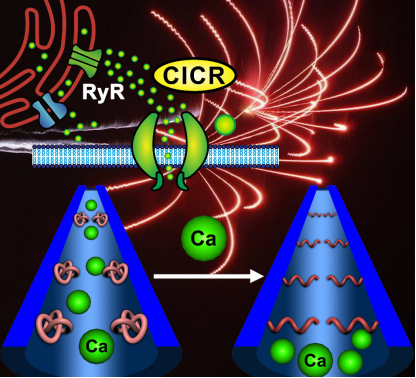In nature, ion channels play a key role in controlling ion transmission between cells and their surroundings. Calcium ion (Ca ion) induced Ca ion release (CICR) is the key control mechanism of the Ca ion channel, which occurs during the regulation of the Ca ion concentration gradient in synergy with the Lannine receptor, which is called "calcium spark". Inspired by this self-regulating biological process, through the fusion of poly {N-isopropylacrylamide-co-acrylamide- [4-(trifluoromethyl) phenyl] -2-thiourea0.2-co-propene amide, developed a smart nano channel system for Ca ion concentration adjustment. The three-component copolymer of PNI-co-CF3-PT0.2-co-DDDEEKC0.2 was grafted onto the nanochannels of porous anodized aluminum oxide (PAA) membranes. In this smart polymer design, the DDDEEKC heptad unit has a strong binding affinity with Ca ion through the coordination bond, and CF3-PT functions as a hydrogen bond regulator unit, promoting the PNI main chain to respond significantly to Ca ion-specific adsorption. Conformational change. Because of these characteristics, the dynamic transmembrane behavior of modified nanochannels can be precisely controlled by Ca ion concentration. In addition, the sensitive Ca ion response is as low as 10 pM, and the high specificity for Ca ion can distinguish Ca ion from other potentially interfering metal ions (e.g., K ion, Cu ion, Mg ion, Zn ion, Fe ion, and Al ion), and significant morphological changes of the nanochannel , And satisfactory reversibility, indicating that Ca ion responsive polymers have great potential in the construction of biochips and artificial nanochannels.
Smart Polymer–Based Calcium Ion Self-Regulated Nanochannel by Mimicking Biological Ca2+–induced Ca2+ Release Process.
Yunlong Li, Yuting Xiong, Dongdong Wang, Xiuling Li, Zhixiang Chen, Cunli Wang, Haijuan Qin, Jinxuan Liu, Baisong Chang, and Guangyan Qing*
NPG Asia Materials 2019, 11, 46.
DOI: 10.1038/s41427-019-0148-4
